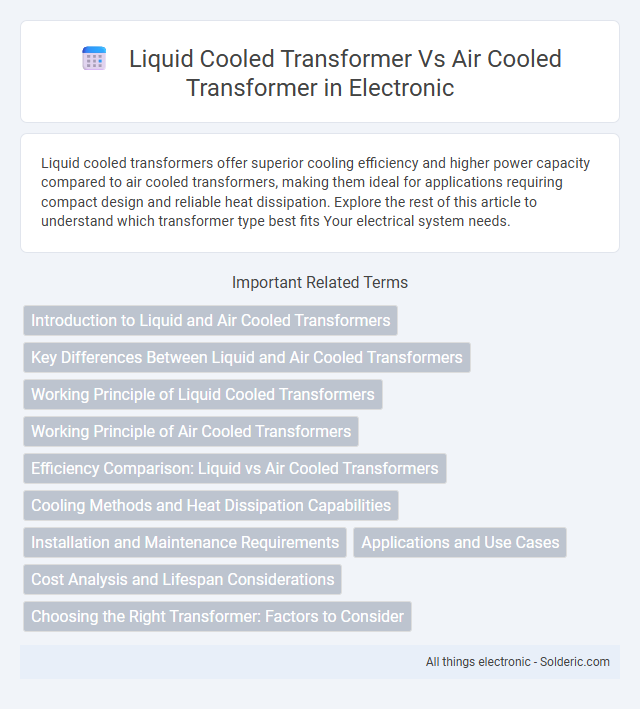Liquid cooled transformers offer superior cooling efficiency and higher power capacity compared to air cooled transformers, making them ideal for applications requiring compact design and reliable heat dissipation. Explore the rest of this article to understand which transformer type best fits Your electrical system needs.
Comparison Table
| Feature | Liquid Cooled Transformer | Air Cooled Transformer |
|---|---|---|
| Cooling Medium | Oil or other insulating liquid | Ambient air |
| Heat Dissipation Efficiency | High | Moderate to Low |
| Size and Weight | Compact, heavier due to liquid | Larger and lighter |
| Maintenance | Requires regular oil checks and potential oil replacement | Minimal, mostly cleaning of fins and fans |
| Installation Cost | Higher due to complexity and materials | Lower |
| Operational Environment | Suitable for high power and harsh conditions | Best for moderate power and clean environments |
| Fire Risk | Higher, oil is flammable | Lower |
| Lifespan | Longer with proper maintenance | Moderate |
Introduction to Liquid and Air Cooled Transformers
Liquid cooled transformers utilize oil or other insulating fluids to dissipate heat efficiently, enabling higher load capacities and improved performance in compact designs. Air cooled transformers rely on natural or forced airflow to manage temperature, offering simpler maintenance and lower initial costs but limited power rating compared to liquid cooled types. Your choice depends on application requirements, space constraints, and cooling efficiency needs.
Key Differences Between Liquid and Air Cooled Transformers
Liquid cooled transformers use oil or other dielectric fluids to dissipate heat efficiently, allowing for higher power density and better performance under heavy loads compared to air cooled transformers, which rely on ambient air circulation for cooling. The liquid cooling system enhances heat transfer, reducing the risk of overheating and extending the transformer's lifespan, whereas air cooled transformers typically feature fins or fans to increase airflow but have limitations in high-temperature environments. Your choice between the two depends on factors like installation space, maintenance requirements, and load demands, with liquid cooled transformers favored for high-capacity applications and air cooled designs preferred for lower power or outdoor settings.
Working Principle of Liquid Cooled Transformers
Liquid cooled transformers use insulating oil or other liquids to absorb and dissipate heat generated by the core and windings, maintaining optimal operating temperatures. The liquid circulates either naturally through convection or is forced by pumps, transferring heat away from internal components to external radiators or heat exchangers. This cooling method enhances efficiency and lifespan compared to air cooled transformers, which rely on ambient air and fans for heat dissipation, making liquid cooled transformers ideal for high-capacity or heavily loaded applications where effective thermal management is critical for your system's reliability.
Working Principle of Air Cooled Transformers
Air cooled transformers operate by dissipating heat generated in the core and windings through natural convection and radiation into the surrounding air. The transformer's surface is designed with fins or radiators to increase the cooling area, enhancing heat transfer efficiency. This cooling method relies on ambient air temperature and airflow, making it suitable for moderate power ratings and less demanding thermal conditions.
Efficiency Comparison: Liquid vs Air Cooled Transformers
Liquid cooled transformers generally offer higher efficiency than air cooled transformers due to better heat dissipation, which reduces energy losses and improves performance. The enhanced cooling capability of liquid systems helps maintain optimal operating temperatures, extending transformer lifespan and minimizing maintenance costs. Your choice between the two should consider operational efficiency needs, environmental conditions, and total cost of ownership.
Cooling Methods and Heat Dissipation Capabilities
Liquid-cooled transformers use insulating oil or other fluids to transfer heat away from the core and windings, providing superior heat dissipation compared to air-cooled transformers, which rely on natural or forced air flow around the transformer surface. The high thermal conductivity and specific heat capacity of the liquid allow for more efficient temperature regulation and enable liquid-cooled transformers to handle higher loads and operate at lower temperatures. Air-cooled transformers, while simpler and less expensive, have limited heat dissipation capacity, making them suitable primarily for lower power applications and environments with adequate ventilation.
Installation and Maintenance Requirements
Liquid cooled transformers require more complex installation, including specialized tanks, pumps, and cooling circuits to manage the coolant, making the setup more space-intensive and time-consuming compared to air cooled transformers. Maintenance of liquid cooled units involves regular inspections of the insulating fluid for contamination or degradation, as well as monitoring for leaks, whereas air cooled transformers primarily need routine cleaning of cooling fins and fan systems. Your choice depends on balancing the higher upfront installation and maintenance demands of liquid cooled transformers against their superior cooling efficiency in high-capacity applications.
Applications and Use Cases
Liquid-cooled transformers are commonly used in high-capacity industrial settings, renewable energy plants, and urban substations where efficient heat dissipation and compact designs are crucial. Air-cooled transformers fit well in smaller-scale applications, such as commercial buildings, rural electrical grids, and light industrial facilities, where lower power ratings and simpler maintenance are priorities. Your choice depends on the cooling requirements, environmental conditions, and space constraints specific to your project.
Cost Analysis and Lifespan Considerations
Liquid-cooled transformers generally incur higher initial costs due to complex cooling system requirements and maintenance but offer extended lifespan through superior heat dissipation, reducing aging of insulation materials. Air-cooled transformers have lower upfront expenses and simpler design but experience shorter operational life because higher operating temperatures accelerate insulation degradation. Choosing between them depends on balancing upfront investment against long-term reliability and replacement costs.
Choosing the Right Transformer: Factors to Consider
Selecting the right transformer involves evaluating cooling methods based on application demands, efficiency, and maintenance requirements. Liquid-cooled transformers offer superior heat dissipation, making them ideal for high-capacity or continuous operation, while air-cooled transformers suit smaller, less intensive environments with easier installation and lower initial costs. Consider your operational load, environmental conditions, and budget to ensure optimal performance and longevity of your transformer system.
liquid cooled transformer vs air cooled transformer Infographic

 solderic.com
solderic.com